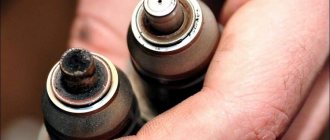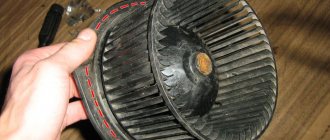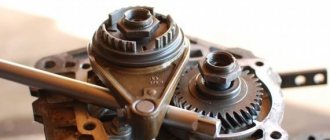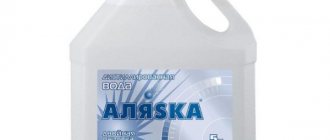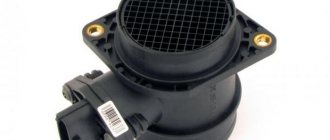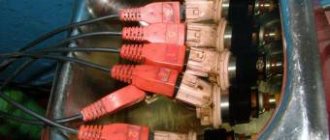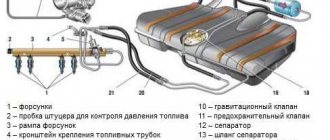Checking and replacing injectors on a Lada Granta car
Tools (for 8-valve engines):
Tools (for 16-valve engines):
Parts and consumables:
Notes:
If the injectors on a car fail, the following signs of injector malfunction are possible: - difficult starting of the engine; — unstable engine operation; — the engine stalls at idle; — increased crankshaft rotation speed at idle; — the engine does not develop full power, insufficient engine response; — jerks and dips in engine operation when the car is moving; — increased fuel consumption; — increased content of CO and CH in the exhaust gases; — glow ignition due to leaking injectors.
In points where there are two photos, the first shows the process on an 8-valve engine, and the second on a 16-valve engine.
1. Disconnect the injector and engine harness connectors as described here (for 8-valve engines) or here (for 16-valve engines.
2. Carry out an initial check of the injector windings. To do this, connect the tester to the connector contacts one by one.
Note:
The connector has five contacts: four for supplying a control signal to the injectors and one for common ground (a crimson wire with a black stripe is connected to it).
3. Connect each of the four control contacts in turn to the common contact and measure the resistance in each case.
Note:
It should be equal to 11-15 Ohms. If one or more measurements show resistance different from the specified value, some injectors are faulty.
4. To more accurately check the injectors, remove the fuel rail from the vehicle as described here (for 8-valve engines) or here (for 16-valve engines.
5. Remove the injectors from the fuel rail as described here (for 8-valve engines) or here (for 16-valve engines.
6. To identify a faulty injector, connect a tester in ohmmeter mode to the injector contacts.
Note:
It should show a resistance of 11-15 ohms. If the winding resistance is not normal, replace the injector, as it cannot be repaired.
In case of replacement, buy new injectors with exactly the same markings.
7. Check the injector for the shape of the fuel spray and for leaks at a specialized service station, since such a test directly on the car is very fire hazardous.
8. Whenever you remove injectors, be sure to replace the O-rings on all injectors on both the fuel rail side and the sprayer side.
9. If you are installing old injectors, carefully wash their nozzles with solvent or carburetor cleaner.
Note:
It is not allowed to wash the injectors by immersing them in a detergent composition to avoid damaging their electrical parts.
10. Install the injectors on the fuel rail in the reverse order of removal.
Note:
Before installing the injectors, lubricate the O-rings with engine oil.
11. After installing the fuel rail on the intake pipe and connecting the pipeline to the fuel rail, start the engine and check the tightness of the connection of the pipeline and the injector seals.
Source
How to clean the injectors yourself by removing them from the engine
To wash them, you need to install a system similar to the stand used in such cases. This will require two cans of washing liquid.
You need a piece of hose, approximately 15 centimeters in length. A pair of clamps. In addition, you will need:
- knife,
- twelve-volt light bulb (you can do without it),
- two-pin button (without locking device),
- a DC power source providing twelve volts - this is necessary for the valves to open (a regular phone charger will do just fine).
The wire going to ground is disconnected from the battery. Operations to remove the nozzles are being carried out. That is, the air filter, throttle body, manifold, accelerator and gearbox cable, breather hose and BDZ heating hose are removed.
All injector chips and hoses connected to the manifold are removed. To prevent fuel from getting onto the ramp, the return line of its supply is unscrewed next to the power steering reservoir. After this, you can remove the ramp and remove the injectors.
Next stage. The hose is attached with clamps to the nozzle and tube located on the lid of the cylinder with a special liquid. To release it from the nozzle you need a container.
The red charging wire is connected to the button, the second is connected to the injector contact. In order not to burn the coil in the nozzle, a 12-volt lamp is connected to the assembled circuit.
Checking the operation of the assembled circuit is quite simple. You just need to press the button. The lamp will light up and a faint click will be heard.
Next, you need to press the button on the can, which will create pressure in the hose. Then turn on the power to the assembled circuit. This operation should be done several times, ensuring that the stream from the nozzle has a pronounced cone and becomes homogeneous.
After all injectors have been washed, reassembly should be carried out. It is performed in the reverse order to that given above.
Signs of clogged injector nozzles
Most modern cars are equipped with injection engines; the days of carburetor engines are gone forever. Injection power plants are more economical, environmentally friendly and productive, but at the same time they have a more complex design and injection system, consisting of a pressure regulator, injectors equipped with an electromagnetic valve, a fuel line, a fuel rail, intake valves and a number of other parts.
During operation, various fine particles and heavy fractions (sulfur, olefin, benzene and a number of others) are deposited on the designated parts, which come along with the fuel and can accumulate in the form of varnish and resinous deposits. In turn, this leads to contamination of the injectors, a change in the direction and shape of the spray pattern, and in some cases a complete cessation of fuel supply, even when using fuel filters that are capable of filtering out particles larger than 10-20 microns.
As a result, the formation of the air-fuel mixture is significantly deteriorated, the tightness of the pressure regulator valve is also compromised, and engine performance is reduced.
The deposition of these substances can interfere with the normal functioning of the working elements inside the nozzle, namely, it can disrupt the tightness of the valve, which is opened by an electromagnet controlled by the BC. In this case, when closed, they will allow gasoline to pass through due to constant pressure in the fuel system.
Engine on Grant: features
So, the Grant 21116 1.6-liter 8-valve gasoline engine is a modernized 1.6-liter VAZ 2114 engine. The idea to modernize the VAZ 2114 engine arose in connection with the release of the Grant car and the transition of the entire model range to Euro-4. Initially, ICE 21116 was installed on the Lada Priora and then on the Lada Granta and Lada Kalina cars. List of main technical characteristics:
- injection power system;
- in-line 4-cylinder engine with a power of 87 hp;
- engine capacity 1596 cm3;
- the presence of two valves per cylinder;
- the maximum torque is 140 Nm;
- the presence of an intake manifold with extended channels and a flange for an electronic damper (increased torque);
- new H-module.
The 87 hp Grant engine, especially in comparison with its predecessor VAZ 21114, has a lightweight connecting rod and piston group. This feature of the 21116 engine has its advantages and disadvantages.
By lightening the parts and elements of the internal combustion engine, the service life of the valve-piston group decreases, but at the same time the dynamics and other indicators improve. For example, an increase in power to 87 hp, which is 6 hp. more than that of ICE 21114.
Main characteristics of the Lada Grand car with a VAZ 21116 engine installed on it:
- The maximum speed of the car is 167 km/h;
- Fuel consumption 8.5 l. per 100 km (when driving in the urban cycle);
- Fuel consumption 5.7 l. per 100 km (when driving on the highway);
Let's move on. If we consider the Granta 8-valve engine and its design, the Granta 8-valve engine has several design features that distinguish it from other modifications.
Firstly, the plate honing method is used to finalize the surfaces of the cylinders. Secondly, the presence of oil nozzles allows for more intensive lubrication and cooling of the pistons.
The dimensions of the internal combustion engine parts have also been reduced: the height of the cylinder block is about 197.1 mm; the crank radius is about 37.8 mm; piston ring height 1.2/1.5/2 mm, etc.
Another thing worth noting is the electromechanical throttle module installed at the receiver input. This design solution allows the ECU to fully control both the fuel supply and the air supply to the cylinders.
Let us add that the main design feature of the Grant 21116 internal combustion engine was the lightweight ShPG connecting rod and piston group. In the previous model, exhaust gas flows collided and created back pressure.
For this reason, in the case of the VAZ 21116, the designers decided to lengthen the collector pipes by changing the shape of the cylindrical block and the inlet pattern. As a result, such actions helped reduce losses and resistance.
Signs of injector contamination.
When the injectors of an injection engine of any vehicle become dirty, characteristic signs of malfunction arise, which necessitates the need to clean the engine injectors. Among these signs we note:
It should be noted that even if all the problems listed above are present during the operation of your machine, this does not mean that the cause is clogged injectors. These problems can arise for a large number of reasons - from the failure of any sensor (air meter, throttle sensor, lambda probe, IAC) or a drop in pressure in the fuel system (RDT, fuel filter, fuel pump), to spark plugs.
Lada Granta 21116 engine life, maintenance, pros and cons
The Lada Granta 21116 engine model under consideration differs from its predecessors in sufficient reliability and efficiency. If you take into account compliance with the operating and maintenance conditions (time frames for maintenance), you can significantly extend the service life of the unit.
Features of servicing the VAZ 21116 engine:
- The engine oil and oil filter are replaced every 15 thousand kilometers (recommended by the manufacturer);
- mandatory adjustment of valve clearances and replacement of the valve cover gasket;
- replacing spark plugs, air and fuel filters after 30 thousand kilometers;
- after a run of 90 thousand kilometers, they change the coolant, drive belts, high-voltage wires, etc.
If you study the reviews of VAZ 21116 owners, then the internal combustion engine of the Lada Granta 21116 with an engine capacity of 1.6 and a power of 87 horsepower pulls well at the bottom, as well as when driving at full power.
Fuel consumption per 100 km, even when driving in city traffic (traffic jams, traffic lights), usually does not exceed 10 liters. By the way, the use of AI-95 fuel recommended by the manufacturer can reduce fuel consumption even further.
We also recommend reading the article about how to do tuning the Lada Vesta engine. From this article you will learn about the available methods for tuning the Lada Vesta engine, how to increase power and boost the specified internal combustion engine.
You can also note the normal start of the engine in cold weather, even after the car has been idle for a long time. Also a plus is a reduction in noise (minimal vibration) and an increase in the torque of the internal combustion engine.
The only drawback is a broken engine timing belt, which leads to bending of the valves (as a result, expensive repairs). Also, in some cases, the fragility of the pistons is noted (when they collide with the valves, they sometimes break and require replacement much earlier than their allotted time);
We'll tell you and teach you
There are many reasons for unstable injector operation, the most common of which is contamination of the injectors. How to recognize a “dirty” injector and what to do in this case?
Operating principle of the injector
The fuel injection system of modern cars is implemented on the basis of injectors connected to the fuel rail. An electric fuel pump supplies gasoline under pressure through the fuel lines from the tank to the fuel line of the injector.
The electronic control unit, based on data received from a variety of sensors (mass air flow, throttle position, coolant temperature, crankshaft position, detonation, etc.), sends a signal to the solenoid valve, which opens, resulting in the injection of gasoline from the fuel rail into the intake tract of a cylinder or into the combustion chamber of an engine.
Signs of a “dirty” injector
If the injector nozzles are dirty, not only does the amount of fuel injected through them significantly decrease, but the shape of the cloud of atomized air-fuel mixture also changes.
As a result, engine operation becomes unstable. What does this mean? It is not always possible to start the engine right away, especially in the cold season. During the first seconds of operation, the engine “troubles” - you can hear misfires in one or two cylinders.
The idle speed becomes unstable, the crankshaft speed either increases or decreases.
After the engine warms up, its idle operation returns to normal, but when you press the accelerator pedal sharply, there are delays (“dips”) and jerking before picking up speed, and in particularly advanced cases, the engine may even stall.
The engine's power drops, its throttle response decreases, but its "appetite" increases - fuel consumption can increase by one and a half times. Accordingly, the content of carbon monoxide and hydrocarbons in vehicle exhaust gases increases.
Remember that the engine may experience similar symptoms if there is a vacuum in the fuel tank, a clogged fuel filter, pinched fuel lines or a faulty fuel pressure regulator.
Causes of clogged injectors
As a rule, the injector becomes clogged with gasoline itself.
The main reason for a “dirty” injector is heavy paraffins, which are invariably included in any fuel, even the highest quality. After turning off the engine, a small amount of gasoline always remains in the injector. Its light components evaporate over time, and heavy paraffins settle on the surface of injection system parts in the form of deposits.
Over time, such deposits lead to a noticeable decrease in the throughput of the injector.
During the production of gasoline, it is impossible to completely get rid of heavy paraffins, so when processing fuel, special substances are introduced into its composition - detergents that dissolve paraffin deposits. The most effective of them is polyetheramine.
All this applies to European oil refineries. Domestic oil refiners, at best, add ineffective, cheap cleaning additives to gasoline, and at worst, add nothing, despite the fact that adding a high-quality detergent increases the cost of 1 liter of gasoline by only 1 cent.
Given the above, car owners need to periodically inspect and clean their injectors.
How often? This depends on the operating characteristics of the machine. When driving short distances within the city, cleaning the fuel injection system is necessary after 20 thousand km. For those who drive longer and further - every 40 thousand mileage.
Methods for cleaning the injector
The simplest and most affordable way to clean injectors is to use a high-quality cleaner, which is poured into the car’s fuel tank and the vehicle is continued to be used until engine performance stabilizes.
This method will only help at the initial stage of injector clogging. A more effective procedure is when the car’s fuel system is disconnected from the gas tank and connected to a special stand.
Flushing the system with a special cleaning liquid, depending on the contamination, lasts from 20 minutes to 2 hours.
In particularly difficult cases, it is necessary to dismantle the injector and then wash it with detergent in forward and reverse directions.
The injector is also cleaned using ultrasound, placing it in a so-called ultrasonic bath.
All cleaning methods, except the first, are available only at specialized service stations.
If you have any complaints about the operation of the injector, and washing it by adding detergent to the gas tank did not bring results, give the car into the caring hands of specialists from a car service center.
The article was written by me personally. You have the right to copy it without restrictions.
To begin with, let’s understand that
an injector
is not only a set of control units and sensor equipment, but it is also a very
high-tech fuel supply system
.
If we imagine fuel injection in a carburetor and an injector
, we
will see
some differences.
The carburetor does not have such injection
— fuel is supplied by gravity through the nozzle and it mixes with air on
its way into the engine
and enters the combustion chamber, where it burns safely.
The injector injects fuel
through a
high-pressure
to an open or closed intake
valve
. This is a classic injector and will not be confused with a direct injection injector, where the nozzle is not located on the intake manifold near the valve, but directly looks into the combustion chamber.
That's all the inherent differences between the fuel injector and the carburetor.
In 15.000 - 20.000
thousand kilometers (depending on the engine, driving style and technical fluids) from direct
contact of fuel
with the valve (after all, injection occurs on an open or closed valve),
coke
and deposits in the form of a sponge form.
Because of this, the mixing of the mixture deteriorates. Fuel simply falls
on this “sponge” and is absorbed and flows off the valve in drops.
And this has a very detrimental effect,
first of all,
on starting
a cold engine and on
smooth idling
.
Also, coke and deposits form inside the combustion chamber, increasing the compression ratio
, which leads to
detonation
and
loss of power
, as well as sticking of the piston rings.
Let's sum it up
The choice of method for washing the injector and injectors without removal remains up to the car owner. And each of the methods does its job perfectly. However, several important points should be emphasized once again.
The cleaning agent should be poured into the fuel tank every time the engine oil is changed, and only as a preventative measure to avoid the harmful consequences that arise from malfunctions in the power supply system of gasoline engines. If there are obvious signs of a malfunction, this option can even cause harm, aggravating the problem even more.
The second option is more effective, but it does not always save the driver. Sometimes you still have to spend both time and money on dismantling, cleaning or replacing injectors. Therefore, in order not to let the situation become critical, follow appropriate preventive measures. To ensure your injector has a long and trouble-free service life.
A clean car fuel system is the key to reliable and economical engine operation. The most serious consequences (up to the impossibility of starting the engine) can arise from clogged injectors. For emergency situations, as well as in order not to waste money at car services, it is worth knowing how to clean injectors yourself.
Read in this article
Technical characteristics of the VAZ-21126-77 engine
| VAZ-21126-77 | |
| Installed on cars: | Lada Granta Sport and Lada Kalina Sport |
| Years of production, year | since 2013 |
| Cylinder block material | cast iron |
| Supply system | injector |
| Type | in-line |
| Number of cylinders | 4 |
| Valves per cylinder | 4 |
| Compression ratio | 11 |
| Engine volume, l | 1,6 |
| Power | 120hp/5900rpm |
| Torque | 154Nm/4740rpm |
| Fuel consumption (city/highway/mix), l | -/-/7.8 per 100 km |
| Oil consumption | 50g/1000km |
| Engine oil quantity | 3.5l |
| Engine life (according to the passport/actually) | 200/200 thousand km. |
Let us remind you that in another article we determine the best VAZ engine for a modern Lada car.
Keywords: Lada Granta engine | Lada Kalina engine
Found an error? Select it and press Ctrl+Enter..
- (AEB) Car sales statistics in the Russian Federation for April 2022 (-72.4%) - the largest drop
- How to remove the throttle assembly on LADA cars
- How to automatically open the trunk on a Lada Priora sedan
- If the reverse gear on the Lada Vesta does not engage (AvtoVAZ instructions)
Popular flushing fluids
Among such compositions, the most popular include:
Distinguished by the versatility of Liqui Moly. It can be used when you need to flush the injectors of any car. Disadvantage: carbon deposits on the cylinder head and valves cannot be removed.
Well-cleaning and carbon-removing Wynn's. Used if the car was manufactured no later than 2002. But it is still advisable to make sure that it can be used to wash the injectors of a specific car model.
Carbon Clean can be called something in between the two discussed above.
Laurel liquid gives a good effect. It has almost the same composition as Wynn's. The only serious difference is that the price of Laurel is much higher for the same effect.
Author: Alex October 27, 2022 Category: Maintenance and repair
Not everyone knows that the main reason for clogging and failure of injector nozzles is the low quality of Russian gasoline. Therefore, the procedure for cleaning the power system is most in demand in this country.
However, washing the injector and nozzles without removing them is a fairly simple operation. Although disassembling and cleaning the injector in a workshop is quite expensive. But you can save on this procedure by cleaning the injectors in the “field” conditions, in your garage. In this article we will tell you how to do it yourself.
